 Pirates and Privateers Pirates and Privateers
The History of Maritime
Piracy
Cindy Vallar, Editor
& Reviewer
P.O. Box 425,
Keller, TX 76244-0425
    
Medicine at
Sea
by Cindy Vallar
The
Medicine Chest
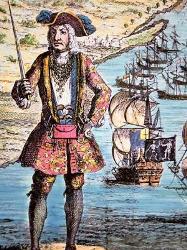 In 1720, Bartholomew
Roberts and the pirates who sailed with him
found themselves in a heated battle with pirate
hunters. His only option was to “cut and run,” so
the pirates dumped their guns and cargo overboard.
They eventually escaped but not without severe
damage to Fortune and her crew. Half were
dead or wounded, and many more would die, for their
surgeon, Archibald
Murray, had left the ship and no one else knew
how to amputate limbs or prevent gangrene. Having no
other options, the wounded were given enough rum to
lessen their pain and left to die. In 1720, Bartholomew
Roberts and the pirates who sailed with him
found themselves in a heated battle with pirate
hunters. His only option was to “cut and run,” so
the pirates dumped their guns and cargo overboard.
They eventually escaped but not without severe
damage to Fortune and her crew. Half were
dead or wounded, and many more would die, for their
surgeon, Archibald
Murray, had left the ship and no one else knew
how to amputate limbs or prevent gangrene. Having no
other options, the wounded were given enough rum to
lessen their pain and left to die.
This is but one account of how sailors fared without
a doctor to tend them. If the ship possessed a medicine
chest, the captain designated someone to tend
patients. That person needed to be able to read and
write, but if he lacked knowledge of Latin, deciding
which medications to give became a problem since
bottles were labeled in that language rather than
the language of the tender. If the ship lacked a medicine
chest, a wounded or ill pirate found his fate
in God’s hands. When William
Phillips injured his leg, Captain John
Phillips allowed John Rose Archer to tend the man.
Archer had some skill with a saw, but cauterization
was beyond his understanding. The red-hot axe he
used to burn the stump destroyed too much and
William was left with even worse wounds than before.
Surgeons who plied their trade at sea, rather than
on land, were not new. They sailed with Roman
warships, and during medieval times, they
accompanied nobility and prelates on their voyages.
When the Spanish Armada sailed in 1588, the
eighty-five surgeons and their assistants were
unable to stop the dysentery
and typhus
that swept the ships.
 John
Woodall’s The
Surgeons Mate, first published in 1617,
aided many in treating what ailed a ship’s crew. The
manual listed the instruments and medicines found in
the medicine chest, and explained how to use them.
Special instructions explained what to do for
medical emergencies, such as an amputation. Various
ailments were also discussed, especially scurvy.
Woodall provided his readers with 281 remedies, but
of the herbs used, he warned that only fourteen were
“most fit to be carried": rosemary,
mint, melilot,
clover, horse radish, comfrey, sage, thyme,
absinthe,
blessed thistle, balm mint, juniper, hollyhock,
pyrethrum, and angelica.
Among the tools and supplies found in medicine
chests were knives, razors, “Head-Sawes,”
cauterizing irons, forceps, probes and spatulas for
drawing out splinters and shot, syringes, grippers
for extracting teeth, scissors, “Stitching quill and
needles,” splints, sponges, “clouts” (soft rags),
cupping glasses, blood porringers, chafing dishes,
mortar and pestle, weights and scales, tinderbox,
lantern, and plasters. This was why medicine chests
were prized almost as much as gold. In fact, when
Blackbeard blockaded
the port of Charleston, South Carolina, he
demanded such a chest in exchange for his hostages
(leading citizens of the town). Contemporary
accounts detailing the incident placed the value of
the medicine chest at between £300 to £400. John
Woodall’s The
Surgeons Mate, first published in 1617,
aided many in treating what ailed a ship’s crew. The
manual listed the instruments and medicines found in
the medicine chest, and explained how to use them.
Special instructions explained what to do for
medical emergencies, such as an amputation. Various
ailments were also discussed, especially scurvy.
Woodall provided his readers with 281 remedies, but
of the herbs used, he warned that only fourteen were
“most fit to be carried": rosemary,
mint, melilot,
clover, horse radish, comfrey, sage, thyme,
absinthe,
blessed thistle, balm mint, juniper, hollyhock,
pyrethrum, and angelica.
Among the tools and supplies found in medicine
chests were knives, razors, “Head-Sawes,”
cauterizing irons, forceps, probes and spatulas for
drawing out splinters and shot, syringes, grippers
for extracting teeth, scissors, “Stitching quill and
needles,” splints, sponges, “clouts” (soft rags),
cupping glasses, blood porringers, chafing dishes,
mortar and pestle, weights and scales, tinderbox,
lantern, and plasters. This was why medicine chests
were prized almost as much as gold. In fact, when
Blackbeard blockaded
the port of Charleston, South Carolina, he
demanded such a chest in exchange for his hostages
(leading citizens of the town). Contemporary
accounts detailing the incident placed the value of
the medicine chest at between £300 to £400.
Unlike today, medicines of the past had to be put
together similar to how a cook baked a cake. The
recipe for a medication consisted of a curative
agent, water or oil, flavoring, and the compound
used to comprise how the medication was given, for
example as a pill or an ointment. The base for the
latter might have been glycerin or lard. Wax
sometimes held a pill together. Ingredients in
ointments and liniments might include mercury,
turpentine, sassafras, thyme, hemlock,
eucalyptole, and/or sulfur. Medicines that were
ingested usually needed some flavoring to make them
palatable; vanilla, honey, licorice, sugar, nutmeg,
ginger, and mint were some that were used. Depending
on what ailed the patient, the pirate might endure bloodletting
to remove toxins from the blood, blisters (a caustic
agent applied with flannel or leather), salves,
clysters (medicines given rectally), or hot, moist
cloths used to relieve pain.
Perhaps Blackbeard required the medicines and
instruments to treat syphilis,
a common plague among sailors and pirates who
frequented brothels when on shore. Of course, his
crew might also have suffered from any number of
other problems, for danger lurked almost everywhere
aboard a wooden ship. Aside from the rats, weevils,
lice, and cockroaches, livestock was kept aboard and
sometimes had free reign of the deck, making for
unsanitary conditions. The pirates’ clothing was
often wet or damp. Depending on where they sailed,
nature might also inflict hardships: sunburn, heat
exhaustion, sunstroke, hypothermia, exposure, or
frostbite. Their work was equally hazardous and
sores, cuts, and bruises were the norm. Scurrying up
or down the rigging and the frequent movement of
both the ship and mast sometimes caused sailors to
lose their footing and fall. Landing in the water
often meant the man drowned, for knowing how to swim
wasn’t a requirement for being either a sailor or a
pirate. If he was lucky enough to be retrieved from
the water, sailors held the victim by his heels and
shook him to remove any water in his chest.
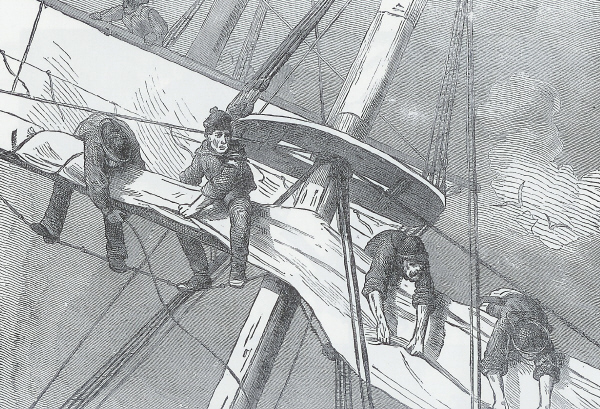
Working aloft to furl the
mainsail
(Source: Nautical Illustrations, Dover)
Landing on the deck might fracture
a person’s skull or kill him. In 1833, Billy Bridle1 was
aloft in the topmast crosstrees. When he tried to
slide down the topgallant halyards, he burned his
hands, lost his grip, fell to the deck (a distance
of twenty feet), and died instantly. Those who
didn’t die from a fall often exhibited symptoms of
“lethargie or frenzie, madnesse, losse of memory,
deadish sleep, giddinesse, apoplexie, paralysis, and
divers other like accidents.” (Friedenberg, 14) From
the seventeenth through the nineteenth centuries,
surgeons treated such head wounds with desiccation
and cicatrization. When the skull bone collapsed, he
raised the depressed fragments and removed any
splinters. Wounds to the chest and abdomen, however,
were left in God’s hands.
Pirates, who visited lands not explored before, also
encountered additional dangers. Alexandre
Exquemelin wrote of the insects on Hispañola:
The gnats
of the third species exceed not the bigness of a
grain of mustard. The colour is red. These sting
not at all, but do bite so sharply upon the
flesh as to create little ulcers therein. When
it often comes that the face swells and is
rendered hideous to the view, through this
inconvenience. (Esquemeling, 33)
.jpg) The
plants could be equally dangerous. He encountered a
manchineel tree near the shore. Although similar to
apples back home, the fruit was poisonous. The
plants could be equally dangerous. He encountered a
manchineel tree near the shore. Although similar to
apples back home, the fruit was poisonous.
. . .
these apples being eaten by any person, he
instantly changes colour, and such an huge
thirst seizes him as all the water of the Thames
cannot extinguish, he dying raving mad within a
little while after. . . . This tree affords also
a liquor, both thick and white . . . which, if
touched by the hand, raises blisters upon the
skin, and these are so red in colour as if it
had been deeply scalded with hot water. One day
being hugely tormented with mosquitos . . . and
as yet unacquainted with the nature of this
tree, I cut a branch thereof, to serve me
instead of a fan, but all my face swelled the
next day and filled with blisters, as if it were
burnt to such a degree that I was blind for
three days. (Esquemeling, 32)
Depending on a pirate’s
ailment, the surgeon might prescribe one of nine
different types of medicines. Aquae – such as
cinnamon water, licorice juice, and fortified
peppermint water – cured hiccups and “stoppeth
vomiting, cureth choler, griping paine of the belly
. . .” according to John Woodall. (Druett, 7)
Spirits, salts, and tinctures – like salts of
wormwood, vinegar, and quicksilver
– cured a variety of ills from urinary problems to
fever. Balsams and resins were given orally or
applied to the skin. Sanguis Draconis, also
known as Dragon’s
Blood, was the resin made from the agave and
rattan palm. Garnet in color, the ground powder was
an astringent and “closeth up wounds.” (Druett, 8)
It was also used to make the varnish used on
violins. Around 1640, Jesuit priests introduced
Peruvian bark (quinine)
to Europe from South America. It was used to cure
intermittent fevers, such as malaria.
It should
be taken in the intermissions between the hot
stages, in the dose of a grain every hour, an
emetic at the commencement of the chill, and a
purge of Calomel and Jalap afterwards having
been given before commencing with the quinine.
(Druett, Rough Medicine, 61)
Syrups were made from
almonds, red roses, saffron, lemons, and other
plants. On board a ship, the surgeon might mix
vinegar of squills (hyacinth) with sugar and honey,
before giving it to a pirate to clear mucus from his
bronchial tubes. Oleum or oils, like oil of Saint
John’s Wort, were applied to the skin. Scottish
surgeons might have used this to treat wounds. The
Scots believed that Saint
Columba favored the plant because it was
associated with John the Evangelist and the Virgin
Mary, although the plant was used long before
Christianity came to Scotland in sacred ceremonies
and to prevent “fairies from spiriting people away
while they slept.” (Darwin, 96) Opiates and theriacs
were also used. An early patent medicine with opium
in it was “Methridatum,” which Woodall recommended
for those “fearfull of waters” and to cure “the
bites of serpents, mad dogs, wild beasts, and
creeping things” (Druett, 8), all of which a pirate
might encounter when visiting exotic places.
Unguents were used to treat burns and abrasions.
Plasters drew bad humors from the body or to treat
open infections, such as wounds received in battle.
In 1500, Giovanni de Vigo, a Roman doctor, treated
syphilis with a poultice called Emplastrum de
Ranis cum Mercurio. Its ingredients consisted
of frogs, “earthworms, viper’s flesh, human fat,
wine, grass from northern India, lavender from
France, chamomile from Italy, white lead, and
quicksilver.” (Druett, 9) One of the oddest plasters
was Pracelsi and was used to treat wounds
sustained in battle. The ingredients, brewed in
autumn, included “burnt earthworms, dried boar’s
brain, pulverized Egyptian mummy, crushed rubies,
bear’s fat, and moss from the skull of a hanged man
which had been collected from the gibbet at moonrise
with Venus ascending.” (Druett, 9) One might think
the plaster was then applied to the soldier’s wound;
in fact, it was applied to the sword that sliced
him.
The last type of medicine came from herbs and roots.
Chamomile flowers soothed headaches and helped with
kidney problems. Other examples included wormwood,
cinnamon, saffron,
rose petals, juniper berries, sarsaparilla root,
mustard seeds, and ginger.
Disease
The most common type of ailment that surgeons
treated was a disease of some kind. To men like John
Woodall, sin was the primary cause of disease,
although the noxious fumes emanating from bilge
water ran a close second. Aside from living a moral
life – not something usually associated with pirates
– the best way to stay healthy was to avoid stinking
vapors and cemeteries whenever possible, and protect
oneself from the night air. Diseases had a nasty
habit of invading ships where large numbers of
people were gathered together in confined places.
Surgeons recognized this fact early in the fifteenth
century. It was one reason that Sir Francis
Drake had to curtail some of his expeditions
against the Spaniards in the West Indies. He wrote
in his journal:
 . . . we were not many dayes at
Sea but there began amongst our people such
mortality, as in a few dayes there were dead
above two or three hundred men. And until some,
seven or eight dayes after our coming from Saint
Jago, there had not dyed any one man of
sicknesse in all the Fleet: the sicknesse shewed
not his infection, wherewith so many were
stroken untill we were departed thence, and
there seazed our people with extreeme hot
burning and continuall ague, whereof some very
few escaped with life and yet those for the most
part not without great alteration and decay of
their wits and strength for a long time after.
In some that dyed were plainly shewn the small
spots, which are often found upon those that be
infective with Plague. (Friedenberg, 16) . . . we were not many dayes at
Sea but there began amongst our people such
mortality, as in a few dayes there were dead
above two or three hundred men. And until some,
seven or eight dayes after our coming from Saint
Jago, there had not dyed any one man of
sicknesse in all the Fleet: the sicknesse shewed
not his infection, wherewith so many were
stroken untill we were departed thence, and
there seazed our people with extreeme hot
burning and continuall ague, whereof some very
few escaped with life and yet those for the most
part not without great alteration and decay of
their wits and strength for a long time after.
In some that dyed were plainly shewn the small
spots, which are often found upon those that be
infective with Plague. (Friedenberg, 16)
The actual disease Drake
described might have been typhus,
cholera,
yellow
fever, or bubonic
plague. He believed the night air was the
culprit for the affliction. Even the surgeon died,
and Drake returned home without any plunder to make
up for the sacrifices he and his men endured.
Among the artifacts recovered from the wrecks of Samuel Bellamy’s Whydah
and Blackbeard’s
Queen Anne’s Revenge
were pewter syringes.
These were used to administer mercury to those who
suffered from syphilis. First described in Europe in
1494, the name stems from a poem Girolamo
Frascatoro wrote in 1530, about a shepherd
named Syphilisive
Morbus Gallicus. The term “syphilis” wasn’t
really applied to the disease until the 1800s.
Spanish sailors called it the French pox, while the
French called it the Spanish Disease.
What did a pirate endure if he contracted syphilis?
The disease had three stages.
- Chancres formed
where contact with an infected person occurred.
These often healed, leaving small scars.
- Six to eight weeks
later, the pirate seemed to contract the flu and
developed a skin rash. Doctors often
misdiagnosed this stage because of its
resemblance to small pox and measles. The
patient soon recovered and believed himself
cured. During this stage, syphilis was
contagious, and the pirate often infected many
others. After two years, the disease entered a
dormant stage.
- The final stage
occurred when syphilis attacked the body’s
systems many years later. Many went mad or blind
before they died.
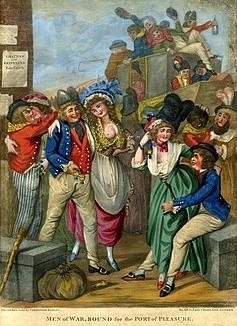 An early treatment2 for
syphilis came from the native peoples in the West
Indies. They used a resin found in evergreen holy
wood or guaiacum.
The more effective treatment was to administer mercury
orally, through a vapor bath, or in the case of
pirates, by injecting the medication into the penis with a
syringe. A salve was applied to the chancres that
developed when first contracted. An early treatment2 for
syphilis came from the native peoples in the West
Indies. They used a resin found in evergreen holy
wood or guaiacum.
The more effective treatment was to administer mercury
orally, through a vapor bath, or in the case of
pirates, by injecting the medication into the penis with a
syringe. A salve was applied to the chancres that
developed when first contracted.
Since syphilis was more or less an occupational
hazard, surgeons treated most pirates over a
long period of time. Whether the mercury was
ingested orally or absorbed through unguents, it
often produced a metallic taste in their mouths that
caused patients to salivate. They didn’t complain
overmuch since many thought it was just the price
they paid for contracting the disease in the first
place. Mercury poisoning sometimes occurred. When
this happened, the pirate lost weight, drooled, had
foul breath and blurred vision, and slurred his
speech. He also had trouble maintaining his balance.
If the treatment for syphilis wasn’t stopped, his
kidneys eventually ceased functioning and he died.
Another disease
that plagued anyone who remained at sea for long
periods of time was scurvy,
which killed more mariners than all the other
diseases, natural disasters, and fights combined.
(Historians conservatively place the number of
deaths at more than 2,000,000 between Columbus’s
first voyage to the New World and the mid-nineteenth
century.) Even physicians of Ancient
Greece didn’t know what caused it. A variety
of folk cures were developed, some of which were
more deadly than the disease. Among these were
swallowing sea water to purge the illness, bleeding,
digesting sulfuric acid, anointing open sores with
mercury paste, and increasing the sailor’s workload.
(The thinking on the last cure was because scurvy
made the sailor lethargic.)
 Scurvy
usually struck about four weeks after a ship left
port. In 1596, William Clowes, an English surgeon at
sea, described what his men suffered: Scurvy
usually struck about four weeks after a ship left
port. In 1596, William Clowes, an English surgeon at
sea, described what his men suffered:
Their gums
were rotten even to the very roots of their
teeth, and their cheeks hard and swollen, the
teeth were loose neere ready to fallout…their
breath a filthy savour. The legs were feeble and
so weak, that they were not scarce able to
carrie their bodies. Moreover they were full of
aches and paines, with many bluish and reddish
staines or spots, some broad and some small like
flea-biting. (Brown, 34)
Just like the pirates and
sailors, those who treated them sometimes endured
the same disease. Another surgeon who sailed on an
English ship in the sixteenth century wrote:
It rotted
all my gums, which gave out a black and putrid
blood. My thighs and lower legs were black and
gangrenous, and I was forced to use my knife
each day to cut into the flesh in order to
release this black and foul blood. I also used
my knife on my gums, which were livid and
growing over my teeth. . . . When I had cut away
this dead flesh and caused much black blood to
flow, I rinsed my mouth and teeth with my urine,
rubbing them very hard. . . . And the
unfortunate thing was that I could not eat,
desiring more to swallow than to chew. . . .
Many of our people died of it every day, and we
saw bodies thrown into the sea constantly, three
or four at a time. For the most part they died
without aid given them, expiring behind some
case or chest, their eyes and the soles of their
feet gnawed away by the rats. (Brown, 34)
 Sir Francis Drake recorded
several outbreaks of scurvy. In 1740, Commodore
George Anson set sail with 2,000 men on a trip
to circumnavigate the world. Of those original
sailors, only about 200 returned to England in 1744.
Ninety percent of those who died succumbed from
scurvy. Sir Francis Drake recorded
several outbreaks of scurvy. In 1740, Commodore
George Anson set sail with 2,000 men on a trip
to circumnavigate the world. Of those original
sailors, only about 200 returned to England in 1744.
Ninety percent of those who died succumbed from
scurvy.
Sir Richard
Hawkins, another Elizabethan
Sea Dog, referred to it as “the plague of the
sea, and the spoil of mariners.” (Druett, Rough
Medicine, 142) In 1593, he was the first to
suggest a remedy: “most fruitfull for this
sicknesse, is sower oranges and lemons.” (Druett, Rough
Medicine, 143) Johan Friedrich Bachstrom
believed scurvy developed because of the lack of
fresh fruits and vegetables. When he announced this
in the 1730s, his fellow practitioners ignored him
because no one else believed this to be true. In
1753, James Lind
published Treatise
of Scurvy, but like Bachstrom his advice
was largely ignored. Another forty-two years passed
before Sir Gilbert
Blane convinced the British Admiralty to
provide sailors with a daily ration of lemon juice.
In doing so, the navy virtually eliminated scurvy
from their ships.
Amputation
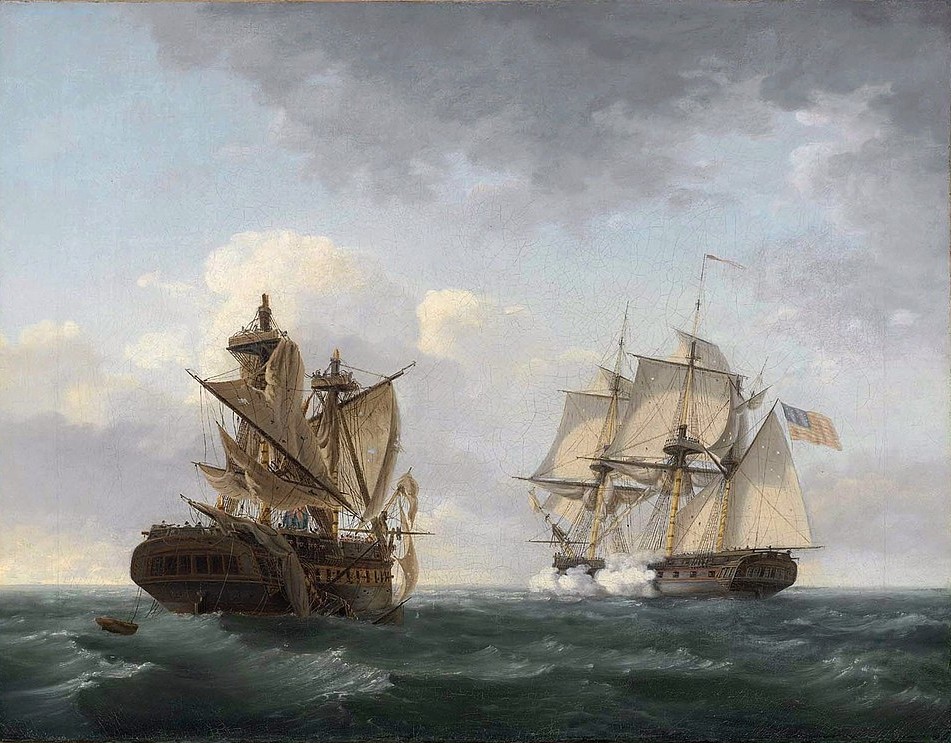 While pirates preferred not to engage
in a sea battle, fighting did occur. Sometimes it
was confined to the actual boarding of the prize;
sometimes the hunter and prey exchanged volleys from
their guns. The injuries inflicted were bloody and
sometimes lethal. After the American frigate United
States defeated HMS Macedonian
on 25 October 1812, a British seaman wrote: While pirates preferred not to engage
in a sea battle, fighting did occur. Sometimes it
was confined to the actual boarding of the prize;
sometimes the hunter and prey exchanged volleys from
their guns. The injuries inflicted were bloody and
sometimes lethal. After the American frigate United
States defeated HMS Macedonian
on 25 October 1812, a British seaman wrote:
The first
object I met was a man bearing a limb, which had
just been detached from some suffering wretch. .
. . The surgeon and his mate were smeared with
blood from head to foote: they looked more like
butchers than doctors. . . .
Our
carpenter . . . had his leg cut off. I helped to
carry him to the after wardroom, but he soon
breathed out his last life there, and then I
assisted in throwing his mangled remains
overboard. . . . It was with exceeding
difficulty I moved . . . it was so covered with
mangled men and so slippery with blood. (Estes,
65)
James Lowry served as a
Royal Navy ship’s surgeon in the Mediterranean fleet
when it attacked Fort Saint Elmo on Malta in
December 1798. His words clearly gave witness to the
dangers during a sea battle, and to the fact that
during a fight, there was no time to mourn the dead.
As I was
dressing a wounded man, a cannon ball struck a
young gentleman on the head dashing his brains
upon all sides; part of them blinded me. At this
moment a splinter struck my head and rendered me
insensible for quarter of an hour. Upon my
recovery, I could hardly persuade myself but
what I was mortally wounded, from being
completely besmeared with blood and brains.
Alas! when I beheld my friend and companion
without a head, I could not avoid reflecting
with emotions of grief; but the field of battle
being no place for weeping or lamentations . . .
I contented myself with the usual expression
upon the field of battle – poor fellow, there he
lies and ends his career. (Lowry, 44)
When a pirate lay hurt,
he usually suffered from a puncture, a slash, or an
amputation. Bullets, shrapnel, and splinters often
caused the first type of wound, whereas a cutlass or
knife caused the second. Projectiles
(ball, shot, or chain) inflicted the last type of
injury. These could inflict a variety of wounds,
especially if the projectile struck wood. Splinters
flew or a mast toppled, crushing anyone unlucky
enough to be under it when it fell. Gunners suffered
scorched burns from spilled gunpowder ignited by a
spark. Descriptions of Dominique
You, one of Jean
Laffite’s privateers, mentioned powder burns
over his left eye that gave him a menacing or grim
appearance. If an explosion caused a fire, sailors
often suffered severe burns.
A wounded pirate eventually found himself placed
upon planks laid across casks to form a makeshift operating
table, if a real table wasn’t available. An
old sail or other cloth might be draped over the
planks. Nearby, smaller flat surfaces or sea chests
held the surgeon’s
instruments and on the floor was a bucket
where amputated body parts were dropped until they
could be carried above deck and tossed into the sea.
Drake, like the buccaneers who came later, often
raided land targets. During one such raid, the party
was ambushed and he was wounded.
The
generall himself was shot in the face under his
right eye and close by his nose, the arrow
piercing a marvelous way in under basis cerebris
with no small danger of his life besides that,
he was grievously wounded in the head. The rest
being nine persons in the boat, were deadly
wounded in divers parts of their bodies, if God
almost miraculously had not give cure to the
same. For our chief Surgeon being dead and the
others absent by the loss of our vice-admirall,
and having none left us but a boy, whose good
will was more than any skil he had, we were
little better than altogether destitute of such
cunning and helps as so grievous a state of so
many wounded bodies did require. Notwith
standing God, by the very good advice of our
Generall and the diligent putting too of every
man’s help, did give such speedy and wonderful
cures, that we had all great comfort thereby and
yielded God the glory, whereof.
(Friedenberg, 17)
Doctors didn’t know what
caused infection back then, so instruments weren’t
sterilized and bandages weren’t necessarily clean.
Neither did the surgeon wash his hands between
patients. To tend a puncture or slash wound, he
removed “unnatural things forced into the wound” (a
musket ball, pieces of wood or cloth), using a
forceps. (Friedenberg, 11) Then he washed the wound
with water or alcohol, packed it with lint scraped
from linen sheets, and wrapped a bandage around it.
If sutures were needed, he used waxed thread that
might dangle from his lips until needed. Should
infection set in, the preferred treatment was to
bleed the patient.
A pirate who suffered a severe wound to his arm or
leg was more likely to have it amputated since the
tissue and muscle were severely damaged. The last
thing anyone wanted was to have the wound turn
gangrenous, for that usually resulted in death. Most
doctors believed the patient was more likely to
survive if a clean cut was made than if the surgeon
allowed the limb to heal without surgery. John Hoxse,
a carpenter aboard USS Constellation
in 1800, wrote:
as I was
standing near the pump, with a top maul in my
right hand, with the arm extended, a shot from
the enemy’s ship entered the port near by, and
took the arm off just above the elbow, leaving
it hanging by my side by a small piece of skin;
also wounding me severely in the side, leaving
my entrails all bare. I then took my arm in my
left hand, and went below . . . and requested
the surgeon to stop [the bleeding in] my arm [as
it] was already off. He accordingly stopped the
effusion of blood, and I was laid aside among
the dead and wounded, until my turn came to have
my wounds dressed. . . . I was so exhausted that
I fell asleep . . . until . . . I was . . . laid
on a table, my wounds washed clean, and my arm
amputated and thrown overboard. (Langley,
58)
Hoxse received these
wounds during the Quasi-War with France, but didn’t
record the event until forty years later.
When amputation
was required, it had to be done within twenty-four
hours of the wounding. A seaman aboard HMS Macedonian
assisted during an operation.
We held
[one man] while the surgeon cut off his leg
above the knee. The task was most painful to
behold, the surgeon using his knife and saw on
human flesh and bones as freely as the butcher
at the shambles. (Estes, 65)
An injured pirate’s
clothing was cut off and a tourniquet was applied to
slow the bleeding. The surgeon gave him a stick to
bite down on, and while the ship pitched and rolled,
the operation began. First, the surgeon used a
scalpel to cut open the skin above the wound. He
sliced through the muscle to the bone with a knife.
The mate who assisted pulled back the flesh to
expose the bone and a leather strap encircled the
bone to keep it clear of obstruction. Using a saw,
the surgeon then cut the bone and tossed the removed
limb into the bucket.
A strip of
cotton cloth about 2 feet long and 8inches wide
torn up the centre from one end for half the
length is then to be drawn over the flesh closed
around the bone. The ends are brought together
and the whole serves to draw the skin and flesh
up while the bone is sawed off. Very little pain
is felt from sawing a bone – If there is any
splinter or corner left it should be pinched off
with nippers.3
(Druett, Rough
Medicine, 121)
Hot tar was painted on
the bloody stump or the wound was cauterized with a
hot iron.4 This
stopped the profuse bleeding that occurred. Once the
surgeon removed the tourniquet, he placed two large
“rounds” of linen over the stump and lashed it in
place with strips of linen. If a wool stocking cap
was available, this was also pulled over the stump.
The entire operation took eight to ten minutes. The
pirate’s chances of survival? Fifty-fifty.
Contrary to what most people believe, the injured
underwent surgery wide awake. They weren’t given rum
or other alcoholic drinks to numb them for two
reasons. Anesthetics had yet to be invented and the
doctors didn’t want their patients dying from weak
hearts. Opiates or grog weren’t given to them until
after the operation to relieve pain.
Sometimes there was nothing a surgeon could do to
help a wounded man. When this happened, he often
died a slow and painful death. Robert Young, the
surgeon aboard Ardent at the Battle of
Camperdown in 1797, wrote:
Joseph
Bonheur had his right thigh taken off by a
cannon shot close to the pelvis, so that it was
impossible to apply a tourniquet; his right arm
was also shot to pieces. The stump of the thigh,
which was very fleshy, presented a dreadful and
large surface of mangled flesh. In this state he
lived near two hours, perfectly sensible and
incessantly called out in a strong voice to me
to assist him. . . . All the service I could
render . . . was to put dressing over the part
and give him drink.
While pirate
surgeons lacked a full understanding of what
caused disease, they labored as best they could to
cure ship fever (typhus), gripes and fluxes
(dysentery), smallpox, measles, pleurisy and
catarrhal fever, scurvy and beriberi, food
poisoning, venereal disease, yellow fever, and
malaria. The same was true for serious wounds and
injuries. Some surgeons, like Alexandre Exquemelin
and Lionel Wafer, studied and used the cures
recommended by the people native to the various
lands the buccaneers visited. Pirates understood the
value of having a surgeon amongst them. That’s why
doctors and medicine chests were prized plunder.
Notes:
1. Billy Bridle was actually
Rebecca Young, and it was only upon Billy's death
that those on the ship learned he was actually a
woman. She had sailed as a man for two years.
2. Not until the 1940s was
penicillin used to treat syphilis.
3. Dr. John B. King’s
instructions on amputating a leg.
4. The tenaculum, which was used
to tie off arteries, wasn’t employed until after
1750.
For additional information on medicine at sea in the
Age of Sail I recommend:
Pyrate Surgeons
Bibliography
Anderson, Ron. “The
Most Dangerous Man Aboard,” No Quarter Given
(July 1999), 10-11.
Breverton, Terry. Black
Bart Roberts: The Greatest Pirate of Them All.
Pelican, 2004.
Brown, Stephen R. Scurvy:
How a Surgeon, a Mariner, and a Gentleman Solved
the Greatest Medical Mystery of the Age of Sail.
St. Martin’s Press, 2003.
Coote, Stephen. Drake:
The Life and Legend of an Elizabethan Hero.
St. Martin’s Press, 2003.
Cordingly, David. Women
Sailors & Sailors’ Women. Random House,
2001.
Daniel, Mike. “The
French Pox,” No Quarter Given (September
1999), 10.
Darwin, Tess. The
Scots Herbal: The Plant Lore of Scotland.
Mercat Press, 1997.
Druett, Joan.
“Privateer Medicine Chest,” No Quarter Given
(September 1999), 7-9.
Druett, Joan. Rough
Medicine. Routledge, 2000.
Eastman, Tamara. “The
Medicine Chest,” No Quarter Given (July
1999), 5.
Estes, J. Worth. Naval
Surgeon: Life and Death at Sea in the Age of
Sail. Science History Publications, 1998.
Folsom, James. Mariner’s
Medical Guide. James Folsom & Co.,
1864.
Friedenberg, Zachary B.
Medicine Under Sail. Naval Institute Press,
2002.
Lampe, Christine
Markel. “Three Special Syringes,” No Quarter
Given (July 1999), 5.
Langley, Harold D. A
History of Medicine in the Early U.S. Navy.
Johns Hopkins University, 1995.
Lee, Robert E. Blackbeard
the Pirate: A Reappraisal of His Life and Times.
John F. Blair, 2002.
Little, Benerson. The
Sea Rover’s Practice. Potomac Books, 2005.
Longfield-Jones, G. M.
“Buccaneering Doctors,” Medical History 36
(1992), 187-206.
Lowry, James. Fiddlers
and Whores: The Candid Memoirs of a Surgeon in
Nelson’s Fleet. Chatham, 2006.
Rediker, Marcus. Between
the Devil and the Deep Blue Sea. Cambridge
University, 1999.
Ringrose, Basil. “The
Dangerous Voyage and Bold Attempts of Captain
Bartholomew Sharp and Others Performed Upon the
Coasts of the South Sea for the Space of Two
Years,” in John Esquemeling’s The Buccaneers
of America. The Rio Grande Press, 1992.
Selinger, Gail. Complete
Idiot’s Guide to Pirates. Alpha, 2006.
Stewart, Wesley.
“Sea-going Surgeons,” No Quarter Given
(July 1999), 4.
Vallar, Cindy. "Pyrate
Surgeons," Pirates and Privateers
(May-July 2007).
Review
Copyright ©2007 Cindy Vallar
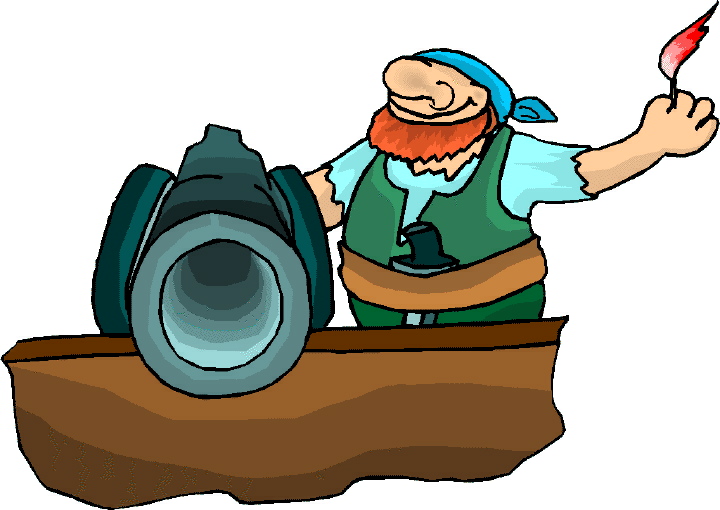
Click to contact me
Background image compliments
of Anke's Graphics |

